|
The Transmission Bands
What type of bands should I use?
This question provokes
considerable discussion and opinion and there is no real "golden rule of
thumb" here.
Basically it's up
to you to make a decision, this page summarizes the different types of band materials, the perceived
pro's and con's and also some images to help
you to select the band lining type that suits you and your T.
One of the main things people often want to know is
how long
will this band last?
In reality, nobody can really tell for sure,
because there are many factors that affect band lining life.
These are some
factors to consider...
There are four main types of band lining material commonly used today...
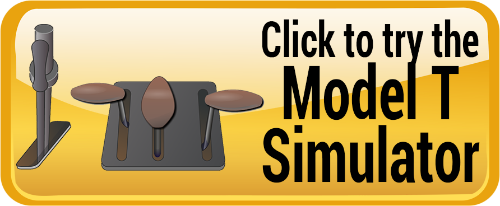
Disclaimer
It is important to
note, the following table is a summary of the experiences of many Model T
drivers from around the world. Each driver has their own style and as such can
affect the life span of the bands of their choice, both positively and
negatively.
|
Type |
Pro's |
Con's |
|
Cotton |
Originality, can be more gentle on drums, relatively cheap |
Easily and rapidly worn out if misused, release lint into engine oil, require regular adjustment, typically shorter life span |
|
Wooden |
Harder wearing, provide harder pedal feel, minimal chatter, require less adjustment |
More difficult to fit, require more pedal effort, can release fibres into oil, some chatter on slow braking |
|
Kevlar |
Typically longer life span, minimal to no adjustment once bedded in, easy to fit, can withstand abuse/higher temperatures |
Require care and frequent adjustment during bedding in, can unravel
at the ends if not treated at installation, resistance to heat can
cause overheating of drums. |
|
Hard |
Typically longer life span, harder wearing, harder pedal feel, improved drum "grip" |
More difficult to fit, can cause jerky changes if not operated properly, linings need to be commercially fitted/bonded |
Cotton Linings
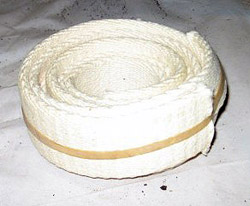 Cotton
woven linings were the original type fitted and specified by Ford. Like all
band materials, if "abused" they will not last their normal lifespan. The
same is true of all other band lining materials, however, the others
described below do seem to last longer when subjected to improper use.
Generally, the cotton lining is "kinder" to the drum surface with damage to
the drum only being caused by the retaining rivets scoring the drum surface.
This in itself does not pose a problem, however, again, like all bands, a
dragging band, caused by improper adjustment WILL result in an overheating
transmission and engine, rob you of power and in the case of cotton linings,
rapidly destroy the band lining. Overheating transmission drums WILL
eventually cause them to crack, making them unuseable. Cotton bands have
been criticised in the past for releasing lint into the engine oil as the
lining wears. If not removed, this lint has been known to block the internal
oil feed line to the fron of the engine, with obvious disastrous results. Cotton
woven linings were the original type fitted and specified by Ford. Like all
band materials, if "abused" they will not last their normal lifespan. The
same is true of all other band lining materials, however, the others
described below do seem to last longer when subjected to improper use.
Generally, the cotton lining is "kinder" to the drum surface with damage to
the drum only being caused by the retaining rivets scoring the drum surface.
This in itself does not pose a problem, however, again, like all bands, a
dragging band, caused by improper adjustment WILL result in an overheating
transmission and engine, rob you of power and in the case of cotton linings,
rapidly destroy the band lining. Overheating transmission drums WILL
eventually cause them to crack, making them unuseable. Cotton bands have
been criticised in the past for releasing lint into the engine oil as the
lining wears. If not removed, this lint has been known to block the internal
oil feed line to the fron of the engine, with obvious disastrous results.
Wooden Linings
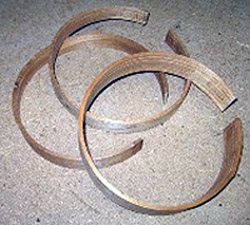 Wooden
linings were originally offered as a "longer life" accessory part during the
life of the Model T. They are a single piece of steam bent hickory fitted to
the normal Model T Transmission band and experience has shown them to have a
long life, often more than the original style Cotton linings. Wooden
linings were originally offered as a "longer life" accessory part during the
life of the Model T. They are a single piece of steam bent hickory fitted to
the normal Model T Transmission band and experience has shown them to have a
long life, often more than the original style Cotton linings.
Because of their nature, they create a different feel to the pedal and have
been reported to cause some level of "chattering" on slow transmission
braking. More so than other types, wooden bands must be very carefully
installed to ensure they are not bent out of shape or even snapped! Wooden
bands have been reported to require considerably more effort in applying the
transmission brake.
Kevlar Linings
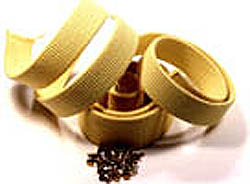 Kevlar
linings often create a fair amount of discussion. They are a modern
alternative lining with Kevlar fibers woven into a polyester band lining.
Kevlar bands have been reported to have an extremely long life span, even
under adverse usage conditions. It seems that they generally need to be more
carefully bedded in and require frequent small adjustments in the initial
run in stage, but after this, require little to no adjustment for very high
mileages. Kevlar
linings often create a fair amount of discussion. They are a modern
alternative lining with Kevlar fibers woven into a polyester band lining.
Kevlar bands have been reported to have an extremely long life span, even
under adverse usage conditions. It seems that they generally need to be more
carefully bedded in and require frequent small adjustments in the initial
run in stage, but after this, require little to no adjustment for very high
mileages.
Because of the nature of the fibers, they have a very high melting point and
can therefore stand a lot of slipping and heat, however, the heat tolerance
of kevlar is much higher than that of the actual drum that it is clamping.
Model T Ford drums are prone to cracking and high levels of heat exacerbate
this considerably, so the heat resistance benefit of the Kevlar is
counteracted by the adverse affect it has on the drum. Of course, with
proper adjustment and even moderate care when driving, this is not a
problem, but you should be aware that this can happen. It most cases, it is
believed that properly fitted and used kevlar bands will outlast the car.
Only time will tell.
"Hard" Linings
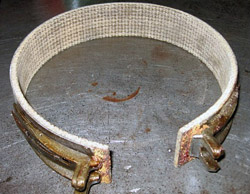 Hard
bands are standard Model T Ford transmission steel bands that have a
composite material bonded then riveted to them. The material is similar to
modern brake linings. These bands give a very different feel to the pedals,
with much more of a "bite" feel. The sensation is of a definite "grip" of
the drum and seems to noticeably increase the feel, in particular of the
brake drum. They are however, not as forgiving of sloppy driving habits and
can give a jerky change between gears if not done properly and/or stalling
of the engine if the revs are not correctly maintained when starting from a
standstill. Like wooden bands, Hard bands must be installed with great care
to avoid bending and damaging the hard bonded surface. Hard
bands are standard Model T Ford transmission steel bands that have a
composite material bonded then riveted to them. The material is similar to
modern brake linings. These bands give a very different feel to the pedals,
with much more of a "bite" feel. The sensation is of a definite "grip" of
the drum and seems to noticeably increase the feel, in particular of the
brake drum. They are however, not as forgiving of sloppy driving habits and
can give a jerky change between gears if not done properly and/or stalling
of the engine if the revs are not correctly maintained when starting from a
standstill. Like wooden bands, Hard bands must be installed with great care
to avoid bending and damaging the hard bonded surface.
|

